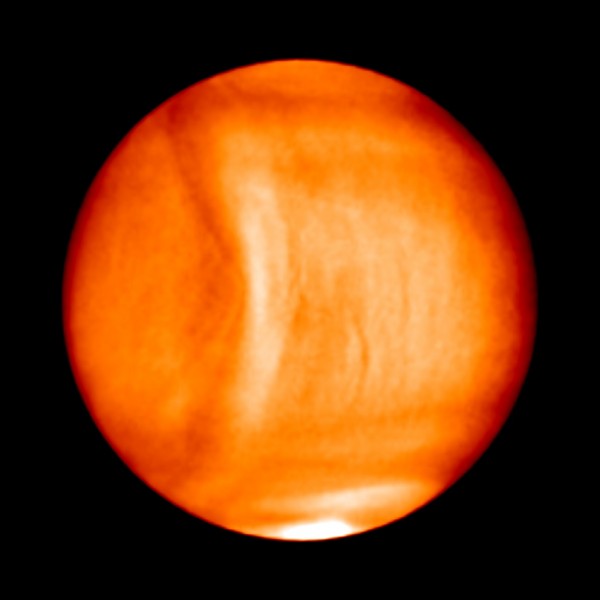By Ana Verayo, | January 17, 2017

Infrared image obtained by the Akatsuki Venus Climate orbiter in December 2015 showing gravity wave. (Planet-C/JAXA)
A massive "wave" was detected on Venus by the Japanese AKATSUKI (PLANET-C) Venus Climate Orbiter measuring 6,000 miles long, according to a new study.
Like Us on Facebook
When the orbiter arrived at Venus in December 2015, the spacecraft obtained readings and measurements. Mission scientists from the Japan Aerospace Exploration Agency (JAXA) identified this as an "atmospheric gravity wave" that is forming a massive curve-like distortion on the planetary atmosphere.
These gravity waves are produced when fluid or gas are disrupted from its balanced state or equilibrium due to external forces. In Venus, this was most likely caused by wind pushing thick clouds in the lower atmosphere over a possible mountain range at speeds of 225 miles per hour.
This unusual wave shape was formed when gravitational forces reeled in these clouds but settled back in their original state of equilibrium in the eastern regions of the mountains.
There is a similar phenomenon on Earth when strong winds create ocean waves or even cloud tops on mountain ranges as well. However, they are not as gigantic as the one seen on Venus.
Venus is known for its violent weather systems - specifically in its upper atmosphere. However, atmospheric activity beyond the lower atmosphere remains a mystery to scientists.
Researchers suggest that this giant wave began forming in the lower atmosphere and spread out into the upper clouds where Akatsuki detected it.
The results revealed how far more complex the atmospheric conditions of Venus are than previously thought. This massive curve also possessed higher temperatures than its surroundings.
JAXA's Akatsuki probe was launched in 2010 from the Tanegashima Space Center in Japan and is the only satellite orbiting Venus today. This new study was published in the journal, Nature Geoscience.
-
Use of Coronavirus Pandemic Drones Raises Privacy Concerns: Drones Spread Fear, Local Officials Say

-
Coronavirus Hampers The Delivery Of Lockheed Martin F-35 Stealth Fighters For 2020

-
Instagram Speeds Up Plans to Add Account Memorialization Feature Due to COVID-19 Deaths

-
NASA: Perseverance Plans to Bring 'Mars Rock' to Earth in 2031

-
600 Dead And 3,000 In The Hospital as Iranians Believed Drinking High-Concentrations of Alcohol Can Cure The Coronavirus

-
600 Dead And 3,000 In The Hospital as Iranians Believed Drinking High-Concentrations of Alcohol Can Cure The Coronavirus

-
COVID-19: Doctors, Nurses Use Virtual Reality to Learn New Skills in Treating Coronavirus Patients







